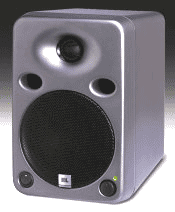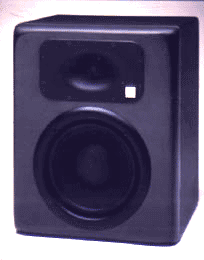
Background And Introduction
Designers and manufacturers of monitor loudspeakers pursue a Holy Grail
all their own: the accurate acoustical representation of the electrical
audio signals sent to their speakers. An ideally designed speaker gives
voice to an audio signal with no added coloration whatsoever--no EQ bump,
no added warmth or brightness. Any coloration or "character" that belongs
in a recording should be in the mix long before signal gets to the
speakers. The current trend in powered near-field monitor speakers
furthers this quest.
By careful design and match of the speaker's internal power amplifier to
the driver units, the designer of a powered monitor can effectively
"divorce" or remove an external power amp's influence over the drivers'
performance and, therefore, the monitor's final sound. This "systems"
approach to accurate monitoring and listening started with studio
control-room design in the late 1970's, where designers controlled the
room's shape, construction materials and placement of the soffit-mounted
monitors. In these studio designs, the entire room and speakers are
designed to work together as a total system to achieve an accurate sound
at a certain focus point. For the most part, engineers were looking for
good on-axis frequency response in these rooms...the mixing "sweet spot."
With the loudspeakers available in those days, they were lucky to get
that! Now, with the wider use of near-field monitors turning any existing
room into an instant monitoring work space, the loudspeaker designer must
go beyond on-axis performance and insure that the monitor performs well
over a wide listening area in most acoustic spaces.
The LSR Philosophy
Linear Spatial Reference, or LSR, is JBL's tag for their measurement and
design philosophy. LSR considers many other factors besides on-axis
performance. Quoting the JBL LSR manual: "...this includes the direct
sound field, the reflected sound field and the reverberant sound field."
These are important factors to producers and engineers who make all major
mixing decisions such as sound image placement, EQ, balance and timbre within
a 30-degree vertical and 60-degree horizontal virtual aperture in front of
the monitor speakers. The LSR philosophy was accomplished by a complete
top-to-bottom design and rethinking of every component in the powered
loudspeaker. From cabinet materials to individual drivers to the final
assembly of the die cast parts, the entire line of LSR units reflects JBL'
s intent to make a line of monitors in sizes to fit every room and
purpose. Their end goal is that sound quality and balance from smaller
production rooms, main music mix rooms and larger dubbing theaters will
translate well.

The LSR Line
JBL makes several speaker systems in the LSR line.
LSR32 is a three-way system with a 12" woofer.
LSR28P is a two-way system with an 8" woofer.
LSR25P is a two-way with a 5.25" inch woofer.
LSR12P is a 250-watt active subwoofer.
The 32, 28 and 25 speakers all have controls to revoice them to co-exist
with an external subwoofer unit. On the front of all of these systems
(except the LSR32) are green LED operating indicators that change to red
when the system is in clip.
For purposes of this review, JBL kindly sent me two pairs: the LSR28P and
LSR25P. Both the 28's and 25's are designed for vertical orientation and I
advise not setting them up differently.
The LSR28P is a bi-amplified reference monitor with the 218F's 8" woofer based on JBL's patented Differential Drive® technology. The monitor measures 406mm x 330mm x 325mm and uses a 250-watt amplifier for the
woofer and a 120-watt amplifier for the high frequency driver. It is
capable of maximum continuous SPL of greater than 108dB at one meter (that
's super loud). The woofer driver uses two 1.5" drive coils to reduce
power compression--the driver actually gets quieter and changes frequency
response when driven harder and harder. There is a third coil that acts
like a "brake," limiting excess cone excursion thus reducing distortion at
high volumes. Supported by a soft butyl surround, the cone is made of a
carbon fiber composite material that forms a rigid, piston-like mechanism.
The high-frequency driver 053ti has a 1" diaphragm and feeds an Elliptical
Oblate Spheroidal Waveguide; i.e., a smooth horn with 100 x 60 degree
dispersion angle.
The LSR25P is the smallest speaker system in the line and consists of a
5.25" rigid woofer piston with a soft butyl rubber suspension. It measures
17.3 x 26.9 x 24.1cm and uses a 100-Watt amp for the woofer and a 50-Watt
amp for the highs. A cast aluminum basket provides heat dissipation for
less compression under full power. The entire driver is shielded for use
near video monitors and other equipment sensitive to magnetic fields
(important especially with the today's computer-based studios). The
titanium high-frequency driver has a 1" composite diaphragm integrated
with a horn shaped the same as the 28.
The LSR25P monitoring system is expressly designed to provide users of
multimedia and digital audio workstations with the same performance
monitoring in smaller environments as users glean from of the larger JBL
LSR32 and LSR28P speaker systems.
Two Sets Of Speakers
Having two sets of JBL speakers at the same time to A/B is fun. I would
expect that the bigger 28's reproduce the lower octaves much better and
clearer than the smaller 25's, so buy a subwoofer if you intend the 25's
for serious monitoring. The 25's are the ticket for a small surround
studios, where you would have five of them around you to do Foley
recording, effects or dialog editing. Using the 25's, I certainly did not
get the feeling I was missing anything in comparison to the 28's...the 28'
s just offer a much bigger, room-filling sound. The 28's are for recording
studios' main near-fields in full-sized control rooms while the 25's are
for personal space monitoring use, such as a small editing bay.
I had an opportunity to play many CD's I have worked on through both sets
of monitors. These are definitely reference monitors because I can hear all the
right and wrong stuff going on with these CD's! Wonderfully non-fatiguing,
both the 25's and 28's did not flatter or hype the sound at all. There is
a remarkable and similar character between both sets of speakers: they are
clear and present mid-range quality, not honky and "forward" sounding. I'll call it the JBL sound, and it makes me nostalgic for the '70's, when I
was coming up as an engineer. Back in the stone ages, there were really
only three monitor choices: the coaxial Altec Lansing 604E; Tannoy Reds or
Golds (also coaxial units); and James B. Lansing's multiple drivers. I was
always happy with these speakers although eventually (at least in L.A.)
the much more powerful JBL systems caught on, especially at the rock and
roll studios.
Evaluation
Speaker evaluation I liken to wine tasting: it takes a while to fully
appreciate, savor and then form an enlightened opinion. Ignoring that
advice, I jumped right into the studio and cut a track using the LSR28P's!
After all, I wanted to test them in the world they are designed for.
LSR28P's don't fold under pressure. I had no trouble using the 28's in the control room since they have both line level balanced +4dBu XLR and -10dBv 1/4" inputs. I had my assistant plug them straight into the console monitor outs, and away I went. One
caveat: Be careful unpacking and setting up the speakers since both the
high-frequency drivers and woofers are fully exposed and easily punctured
by probing fingers. The horns and the rear-positioned reflex ports look
like good places to grip the speaker when pulling it out of the box but
watch out! The accommodating rear panel has an on/off switch, fuse, an AC
mains selector and three-prong IEC (International Electrical Connector)
mains connector, so the hook-up was simple.
For me, getting drum sounds is the supreme test of near-field monitors. I'm old-school: I get drum sounds with the speakers loud. I find that a lot
of powered monitors start to "fold" just as the kit is starting to sound
punchy; clip LED's start flashing away, making it difficult to tell what
is clipping; the speakers, the mics, mic-pre or the mics themselves. The
JBL's did not fold at all and were tireless in reproducing perfectly some
of my worst ever drum tones. Fact is, these speakers didn't disguise
either my slacker engineering or the "flogged-to-death" drum heads my
drummer was trying to squeeze another gig out of. The 28's did great for
mixing as well, with plenty of clear bottom end that translated well when
I played the mix on other systems. I found it easy to place (pan) tracks,
and the flat 50Hz to 20kHz response made balancing and equalizing easy.
I found the 28P's also easy to adjust for various rooms. There is an
eight-position DIP (Dual Inline Position) switch on them for tweaking the
high-frequency level up or down 2dB above 1.8kHz, adjusting the bass
alignment from flat to + or - 2dB and switching input sensitivity from two
different presets or from the input level trim pot on the rear panel. If
you work in a very dead room with lots of high-frequency absorption, you
may want to bump up the high frequencies so your mixes translate to other
systems with just as much brightness. Working in a very live and "splashy"
room can cause your mixes to translate dull; in these cases, try taking
the top end down 2dB and go for more high end when equalizing. I tried all
of these switches and I ended up back to the way the units come out of the
box: all switches down (flat response). This setting held up in the
control room and in my 12x12' listening room at home, which is very
convenient for checking mixes.
After I had a good mix together, I hooked up the 25's and found them to
sound much the same as the 28's...just a scaled-down version with not so
much subsonic extension. Frequency response is rated at 70Hz to 20kHz for
these monitors and all elements of the mix remained in the same balance
both in tonality and level. The 25's have a front-mounted level control,
on/off switch and two reflex ports. I used the XLR input connector (as I
did on the 28's) but there is also a RCA jack for -10dBv levels. The DIP
switch here has four positions: 80Hz high pass mode for subwoofer use; HF
(high frequency) lifted 1.5dB above 2.3kHz; HF reduced 1.5dB above 2.3kHz;
and Boundary Compensation. The Workstation Boundary Compensation control
adjusts the bass and mid-bass output for better sound and correct spatial
response when the monitors are placed adjacent to video monitors on
desktops in typical workstation environments.
Either of these LSR systems can fulfill your monitoring needs for any size
studio. The LSR28P sells for $1,121 (MSRP) each while the smaller LSR25P's
sell for $489 each.
JBL Professional is part of the Harman International network of
professional and consumer audio companies. For more information, contact JBL Professional at 8500 Balboa Blvd. P.O. Box 2200 Northridge, CA 91329. Telephone: 818-894-8850. Web to: www.jblpro.com
| |